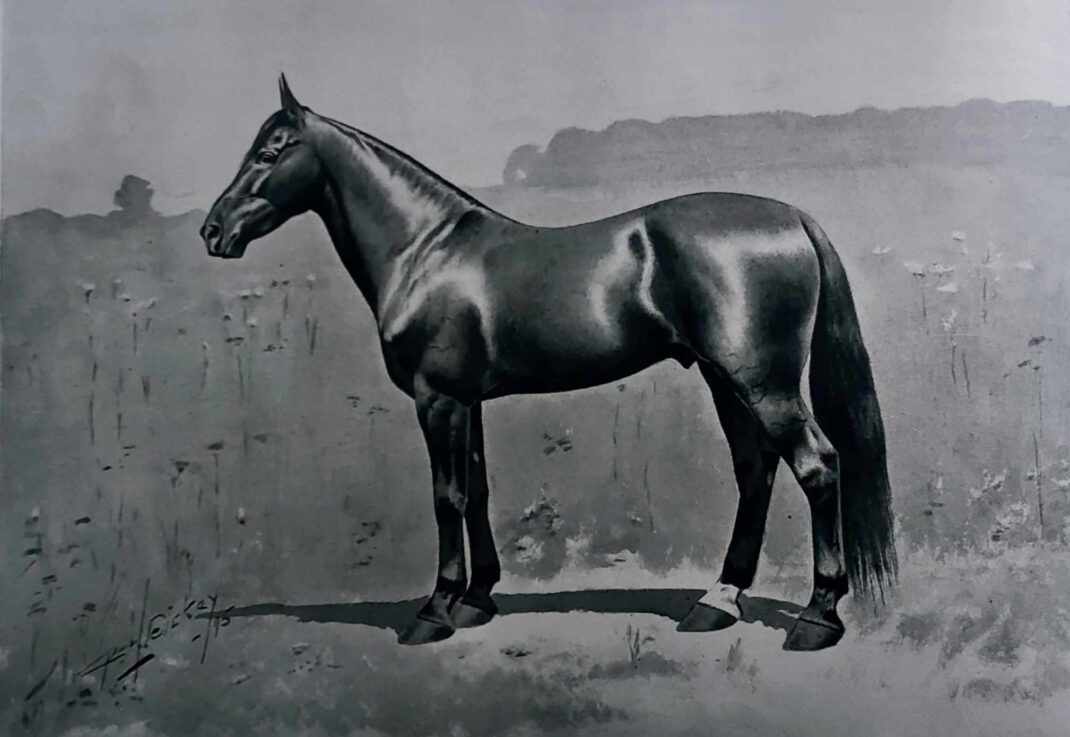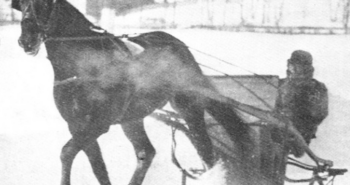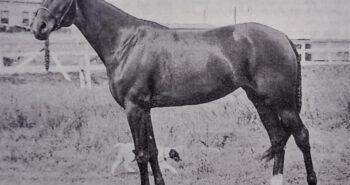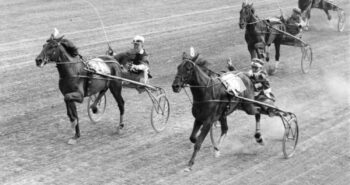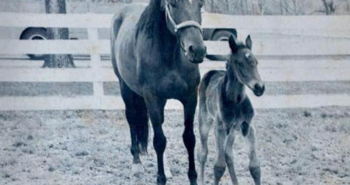While Hambletonian is forever immortalized in the history of trotting, what could possibly have turned out been his best son at stud is largely forgotten. One of Hambletonian’s very first foals, Alexander’s Abdallah was a spectacular sire whose life tragically ended way too early during the Civil War.
Alexander’s Abdallah’s dam, Katy Darling, was one of the four mares bred to Hambletonian when he was an unknown 2-year-old. These breeders were for free, and these four are the only foals of Hambletonian where no service or foal fees were charged. Articles from back then describe her as a spectacular trotter. A March 1896 article in The Breeders and Sportsman said “Katy Darling had the name of being the best road mare of her time on the old Third Avenue speedway. It was the custom back then for everybody who drove a trotter out to the Red House track in Harlem to leave the rendezvous together for the homeward drive in the afternoon, and that the last man down to Billy Van Cott’s four mile house, which stood on the present site of Proctor’s Pleasure Palace of thereabouts, had to settle for the wine. It is said that in these four-mile races, to wagon, Katy Darling was always in the first flight, fighting for the lead.
Mendham Maid was another of the good ones of that day, and in the winter of 1850-51 a rivalry sprung up between the Maid and Katy Darling for the mastery of the snow path, the outcome being a match race to sleighs, which resulted in a decisive victory for Katy Darling. After celebrating the old-fashioned way, victor and vanquished harnessed together for a moonlight drive up the road that night. When they were some distance north of the Harlem River, on the White Plains road, Katy Darling stepped on a loose stone, or got her foot caught in the frog of a railroad track, as another story has it, and stopped short, so badly crippled that she could hardly hobble to the nearest barn. There she remained until Lewis J. Sutton, of Warwick, Orange County, bought her for $50 the next spring. Sutton managed to get the mare home after much trouble, and late in the Summer he bred her to the Kent mare’s colt, then an unnamed two-year old.”
Breeder Louis Sutton later, in the Breeders and Sportsman on Jan 5, 1895, told his side of the story. According to him, an old-time New York horseman, Carl Young, recommended to Sutton that there was a “mare lying sick in a roadside stable” that he should take home with him, breed her to a good young horse and make a fortune. He told how they drove to when Katy Darling was stabled, “and sure enough, in a stall at the rear lay this mare. She could not get up without help, her near fore leg was swollen from the gambrel clear down to the hoof, and the skin was stretched so it looked like it would burst. But oh what a mare. When we went in that stall she lifted up her head and looked at us, and I saw at a glance this was no common dung-hill mare. She had the head, the neck, the eye, the color, finish, everything that the finest blood only can give. (…) So a day or two after I and another man drove over to bring Katy back to Warwick. We hitched the mare behind the wagon and she managed, on three legs, to hobble the eighteen miles to Warwick. Right there her gameness surprised me; she would come along for half a mile or so, then stop to rest, and then without any urging start along again. You could see, however, the pain she was in every step of the way.
When I got her home I had her leg blistered until we got the swelling down enough to find out the trouble. The coffin joint was dislocated. We got it in place after a lot of trouble, and then after a few weeks’ good feeding and full liberty in a good-sized paddock I got a service to Bill Rysdyk’s Hambletonian, then a two-year-old.”
But what was Katy Darling’s pedigree. All pedigree sites lists her as by Bay Roman, a son of Mambrino, which would make Alexander’s Abdallah 3×3 on Mambrino. But an article in the Breeders and Sportsman in May 1896 casts this in doubt: “In the early volumes of the stud book Katy Darling was registered as “by Bay Roman, dam by a son of Mambrino,” but there is considerable doubt as to the correctness of this pedigree. About twelve years ago George Nelson, an old-time Brooklyn horseman, told the writer more about the early history of Katy Darling than has ever appeared in print. Nelson has traced the mare backed to the colored man who brought her to New York when she was three years old. This man had been a purser, steward, or something of the sort on the New York and Albany steamboats, and he was a very intelligent horseman, according to Nelson’s story. He remembered the mare distinctly, and said he had bought her from the farmer who had raised her, ‘about twelve miles back of Albany.’ He could not then recall this farmer’s name nor the name of Katy Darling’s sire, but he said he could go to the farm, offering to take Nelson there if the latter would pay his expenses. He said the mare was got by a son of Long Island Black Hawk. Before anything further had been done poor Nelson fell in the Wallabout Basin and was drowned, and with his death disappeared the last chance of clearing up the mystery surrounding the dam of one of the greatest trotting sires ever known.”
Selling against his will
On Aug 27, 1852, Katy Darling gave birth to a beautiful colt at Sutton’s farm in Warwick, Orange County, NY. The little one showed so much natural speed that he soon became the talk of the neighborhood, and Sutton eventually sold the colt – but did not mean to do so. In Sutton’s own words to the Breeders and Sportsman, “I had refused many offers. When he was seventeen months old Ezekiah Hoyt and Seely Edsall came over from Goshen to see him. He was in the lot and I was from home; they turned a sheep dog at him. but it would not work; they could not get him to run. ‘I must own that colt, Hoyt,’ said Edsall, ‘no matter what he costs.’
Hoyt met me in the road as I returned, and said ‘Put a price on your colt, Sutton.’ Now I had refused him several times before, bearing in mind what Young had said: ‘If you get a colt he will make your fortune, and if you ever sell him you will have no luck.’ Prophetic words, sir, said the old man sadly, for I have had nothing but ill luck in every venture since.’
Well, thinking $800 would be enough to scare Hoyt, and thinking to make my bluff sure, I said to Hoyt : ‘If you must have a price, I will say $500.’ ‘The colt is mine and the money yours,’ was the unexpected reply. What could I do? I had passed my word, and there ended my connection with the little colt I bad so carefully reared.”
After a while Edsall bought out Hoyt and the horse became known as Edsall’s Hambletonian. The horse only made one official appearance on the track. In a match race he distanced Albion in 2:42 / 1.40,7. At the Orange County fair in 1858 he was awarded first prize for aged stallions.
Going to Kentucky
At little later, in March 1859, when James Miller and Joseph F Love of Harrison County, Kentucky, went to New York to look for a stallion from the Messenger bloodline they ended up buying Edsall’s Hambletonian and in the process his name was changed to Love’s Abdallah (some historical documents quote the price as $2,500 and some as $3,000, regardless it is fair to say the amount was substantial at its time). The stallion was the first son of Hambletonian to stand stud in Kentucky. Until the fall of 1862 he stood at Joseph Love’s farm in Cynthiana, when he was sold to Robert Aitcheson Alexander’s Woodburn Farm, and became known as “Alexander’s Abdallah”.
The legendary Woodburn Farm was established by Robert Aitcheson Alexander, a son of a Scottish immigrant. Alexander bred both runners and trotters – he began to collect his trotting stud in 1856 – and is widely acknowledged as the first to establish a systematic method for breeding. He advanced the introduction to standardbreds into the Bluegrass state, and at his Kentucky nursery he assembled top stallions and, more importantly, a huge number of top mares – several of which have become important historically. In 1858 he bought the legendary thoroughbred stallion Lexington, the leading US sire for 16 years, for $15,000. Two years prior Alexander had bought trotting sire Edwin Forrest, and in 1857 he added Pilot Jr to the stallion roster, and over the next years Woodburn acquired a few other trotting stallions, too. In the fall of 1862 he purchased Love’s son of Hambletonian, who then became known as Alexander’s Abdallah. All this contributed to Woodburn gaining the title “Mother Farm of the Standardbred.”
When the American Civil War broke out on Apr 12, 1861, Robert A Alexander attempted to carry on business as usual at Woodburn. Kentucky was at first a neutral state; on May 16, 1861, the state legislature declared Kentucky neutral after the governor had refused to Abraham Lincoln’s call for troops to the Union army. Three months prior, on Jan 19, 1861, Woodford County had expressed their loyalty to the Union. As William Preston Mangum II wrote in his excellent Disaster at Woodburn Farm: RA Alexander and the Confederate guerrilla raids of 1864-1865, this “made the county vulnerable to Confederate raids. Since it was commonly known that Alexander was a British subject and that the sympathy of the Great Britain early in he war was with the Confederacy, RA believed that Woodburn Farm would be safe from raids by Confederate forces.” In the first half of the Civil War, this was also the case. Kentucky’s neutrality fell when the Confederates attacked Columbus, KY in September 1861 and the legislature petitioned the Union army for assistance. By the spring of 1862 most of the state was controlled by the Union, but for the rest of the Civil war there were sporadic guerrilla warfare and raids. Farms were regularly targeted in other to take fresh horse. Writes Mangum, “as the war began to draw to an end, however, Confederate guerrilla operations increased in central Kentucky. Alexander seemed unperturbed, although the guerrillas displayed a thorough knowledge of farms around Midway and Versailles and constantly harassed other breeders. Many breeders suffered severe losses from their depredations.”
On Oct 22, 1864, saw the first major raid on Woodburn when five thoroughbreds, including stars Asteroid and Bay Dick, and a few more as well (although the historical records differ on this), were stolen during the middle of the day. Magnum: “Alexander, his employees, and several neighbors pursued the guerrillas as far as the Kentucky River. At the river some ten miles from the farm the guerrillas halted, and the groups exchanged shots. Alexander’s party made a charge ‘which threw them [the guerrillas] into confusion,’ causing them to scatter. One of the raiders (believed to have been the leader) riding Asteroid, plunged into the river. The colt swam across the river under a hail of bullets. The pursuit continued and five of the horses were recovered.” Asteroid was recovered ten days later and was in miraculously good shape.
The disastrous raid
According to Mangum, “aware of the danger that continued the hover around the farm and committed to protect his horses, Alexander decided to post armed guards.” Still, this wasn’t enough to prevent it from happening again. With the American Civil War slowly nearing the end, on the evening of Feb 2, 1865, a guerrilla of 25 people led by Sue Mundy, who also led the previous raid on the farm, and Frank Quantrill launched another raid on Woodburn. The guerrillas wore federal overcoats and the armed guards thus didn’t attempt to stop them. Robert A Alexander met the guerrillas in the kitchen doorway of his house and the raiders quickly revealed their true identity. The farm owner “was not a man accustomed to taking orders even when staring at the barrels of the raiders’ guns. He was willing to risk his life to protect his horses and farm; he began to stall for time and continued this tactic during the raid.” The raiders had the upper hand, though, and had taken Warren Viley, one of his neighbors, hostage and brought him along.
Alexander first took Quantrill and his men to the stable nearest the house which, according to a letter the owner later wrote, “a pair or thoroughbred mares well broken to harness, a thoroughbred horse used as a saddle horse and some 2 or 3 of less value.” Though Alexander tried to pass the horses off as very good stock, the guerrillas knew exactly who and what they were looking for. Quantrill specifically asked for the horse known as “bald horse” and insisted on this one when Alexander tried to convince him to take a different horse – but to no avail.
According to Mangum, “the guerrillas took their pick of 16 valuable horses at Woodburn, including Alexander’s Abdallah, Bay Chief (“the bald horse”) and Nannie Butler (great-grandam of Typhoon II, winner of the 1897 Kentucky Derby). Several workers pleaded with them not to take Alexander’s Abdallah since he at the time was “fat, bare footed and only a few days before his feet had been trimmed and pared down. No horse on the place could have been selected so little fitted to endure a long hurried ride over flinted roads.” Additionally, the guerrillas were offered $10,000 to leave Bay Chief (“the bald horse”) alone, but ignored the offer. Bay Chief, a son of Mambrino Chief, had few foals but left a legacy as the paternal grandsire of legendary trotter Minnehaha.
Trying to escape
Leaving the legendary farm, the raiders headed to nearby Midway where they burned the railway depot and telegraph office. Separately, a messenger rode from Woodburn to Lexington to raise the alarm, and a company from the 12th Ohio Cavalry, encamped in Lexington, gave pursuit. Heading in the direction of Lawrenceburg, the guerrillas then broke up.
Early the following morning, on Feb 3, Quantrill’s band were attacked in Anderson County. The guerrilla leader managed to mount Bay Chief, who was very recognizable because of his bald face. The horse was shot “through the muzzle, through both thighs and one hock. In his condition he carried his rider two miles in the retreat, when the horse was so weakened by loss of blood, that a Federal cavalryman overtook them. His pistol being empty, the soldier aimed a blow at Quantrill, but missing him lost his balance and fell from the horse. The guerrilla leader quickly saw his opportunity, jumped from Bay Chief, mounted the soldier’s horse and escaped.” Despite his severe wounds Bay Chief managed to hang on for ten days before he passed.
Alexander’s Abdallah was also part of this skirmish, “but his rider escaped by plunging him into a nearby river.” The horse was then forced to swim across the river. The 13-year-old stallion was then left at Lawrenceburg where he was later recovered. Says Mangum, “the most factual account states that Abdallah and Bay Chief, and likely the other Woodburn horses, were involved in the fight in Anderson County with the Home Guards of Woodford County. To make his escape, Abdallah’s rider forced his hot and steamy mount to swim across an icy river. Abdallah was ridden as far as Lawrenceburg, just south of Frankfort and about sixteen miles from Woodburn, where he finally gave out. Hull was quoted as saying that Abdallah ‘was left in a deplorable condition … in a barn where there were sixteen other horses exhausted from being over ridden.’ This account adds to the evidence that Abdallah was discovered with other horses in the barn and not by the roadside as many writers have claimed. When Abdallah was were bruised and bleeding, but he might have recovered if he had not been so hot when he swam the river. Pneumonia set in, and Alexander’s Abdallah died on Feb 6, 1865, in Mr Bush’s barn where he had been found.”
The devastating loss
The loss of his two trotting stallions and four other horse dealt a crushing blow to Robert A Alexander. He would point out that “we can console ourselves with the idea that it might have been far worse,” but was clearly devastated. Magnum points out that “there can be little doubt that the mistreatment of his horses upset Alexander as much, if not more, than his financial losses. He was so distressed that he immediately decided to move his remaining stock to Illinois and Ohio. He decided to seek a safe haven for his horses in Illinois because he owned land and flour mills there – Black Hawk in Aurora and Airdrie Mills in Montgomery, both on the Fox River.” Later the same month, in Februar 1865, “Alexander sent Pilot Jr and 42 head of trotting breeding stock to Montgomery. He shipped the horses secretly by night on the Lexington and Frankfort Railroad from Spring Station which was a little over a mile from Woodburn Farm.”
Alexander started complaining about poor health in 1865, presumably in part a reaction from the raid. A little more than two years later he had deteriorated considerably: “by the summer of 1867 Alexander’s health began to alarm his friends and family. He had been a slender, somewhat frail-looking man all his life, although he never spared himself and was incessantly active (…) He seems to have become depressed: his spirit had been broken. The stress of way, the worry of the raids, the loss of his prize horses, and the financial anxiety of moving the horses to Illinois and Ohio and back to Kentucky began to take their toll.” He became seriously ill in November that year and died Dec 1, 1867, at Woodburn.
Robert A Alexander’s death was in many ways the final casualty of the attack on Woodburn.
A massive legacy
Alexander’s Abdallah entered stud at 4, and in his first season at stud when he sired the famous Goldsmith Maid 2:14 (1.23,3), a truly spectacular trotting mare. However, the Maid hadn’t even started by the time her sire passed away in Kentucky. The second fastest trotter got by the legendary sire was Thorndale 2:22 1/4 (1.28,4), born in Kentucky in 1865 after this sire had passed. Another son was Major Edsall 2:29, sire of Robert McGregor 2:17 1/2 (1.25,5), who in turn the legendary Cresceus 2:02 1/4 (1.16,0). Goldsmith Maid and Cresceus are considered the best ever hailing from Alexander Abdallah’s sireline.
Thorndale’s dam was by Mambrino Chief, just like two of Alexander’s Abdallah’s most successful sons at stud: Almost and Belmont. The latter were never trained, but were fast natural trotters. They were, however, his most successful sons at stud. It is through Almont that Alexander’s Abdallah is everywhere in today’s pedigrees, as that son of Alexander’s Abdallah is found on the maternal side of both Peter Volo and Peter Scott – both of these have Alexander’s Abdallah twice on the maternal side. He is also found once the pedigree of Bingen, and three times in the pedigree of San Francisco. Belmont sired Nutwood 2:18 3/4 (1.26,2), whose record was the world stallion record when made. Alexander’s Abdallah is also found in Dan Patch as he is the paternal grandsire of the top pacer’s grandam Abdallah Belle.
In The Kentucky Harness Horse, Ken McCarr wrote “no one knows the immensity of the loss to Kentucky and the horse world by the death of this thirteen-year old horse. It was hard to judge his true worth to Kentucky, for many of his Kentucky foals were lost in the war. But while still in New York, Abdallah had begotten a mare called Goldsmith Maid. This mare lowered the world trotting record seven times (…) If Alexander’s Abdallah could get a daughter like Goldsmith Maid from an old broken-down road mare, he would surely have revolutionized the harness racing sport if he had had access to the great mares at Woodburn and elsewhere in Kentucky.”
Similarly, in Oct 1889, the Breeders and Sportsman wrote “When a horse foaled in 1852, after very slight stud service in New York is taken to Kentucky in 1859, put in the stud in a locality where, according to General Withers, who then lived there, there were no trotting mares, getting scarcely any patronage, in 1863 taken to Woodburn, where the country was all ablaze with the fires of Civil War, getting a few colts and fillies there, and then dying in 1865 from hard riding and neglect, producing altogether less than two hundred foals — when such a horse, under such unpropitious circumstances, becomes the sire of the incomparable Goldsmith Maid, that won more heats inside of 2:30 than any other horse ever trotted in that time: of the marvellously prepotent Almont, whose line, like Tennyson’s brook, seems to ‘go on forever’ and to gather force and volume every year; of the great Belmont, that sired such a horse as Nutwood, and of the excellent Thorndale; and out of these less than two hundred foals produces twelve sires of about ninety 2:30 performers, with an almost innumerable host of 2:30 descendants in the remote generations – such a horse as this, in my humble judgment, deserves the highest rank that a trotting stallion can.”
Generally Electioneer and George Wilkes are considered the best sons of Hambletonian. There can, however, be no doubt that Alexander’s Abdallah should be considered to be of similar quality – at least. It was impossible to say what could have been but all trotting historians agree that the early passing of Alexander’s Abdallah was a big loss to trotting.
Alexander’s Abdallah
(ex Edsall’s Hambletonian, Love’s Abdallah)
Bay colt born in Orange County, NY on Aug 27, 1852. Died in Lawrenceburg, KY on Feb 6, 1865.
(some sources give Feb 5 as the date of death)
Hambletonian 10 – Katy Darling (Bay Roman)
1 start: 1-0-0 – 2:42 (1.40,7)
Breeder: Louis Sutton
Owners: Louis Sutton – Hezekiah Hoyt and Major Edsall – Major Edsall – James Miller and Joseph F Love – Robert A Alexander (Woodburn Farm)
Trainer: –
Driver: –
Groom: –

